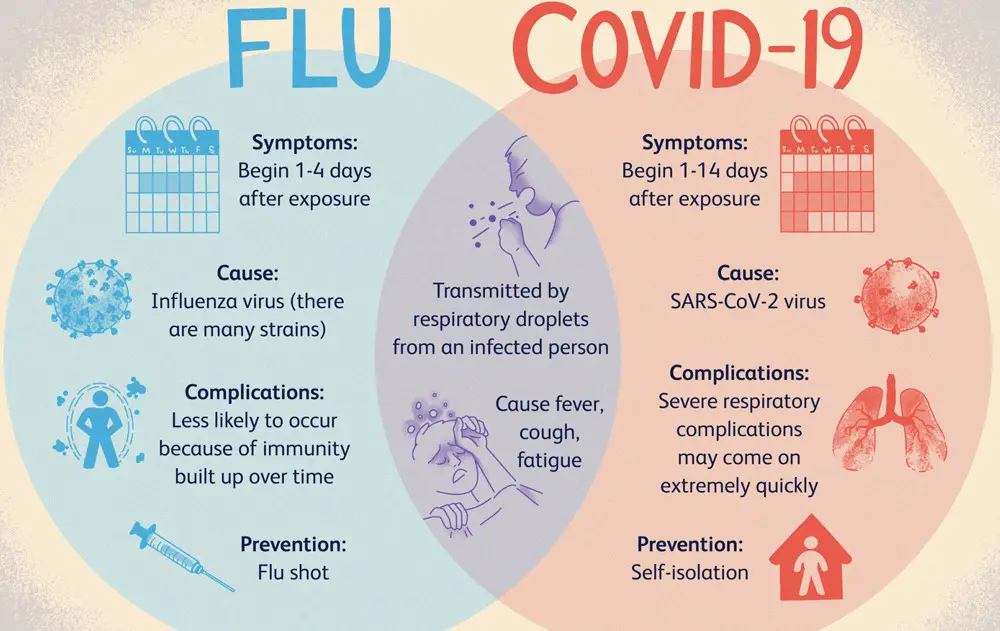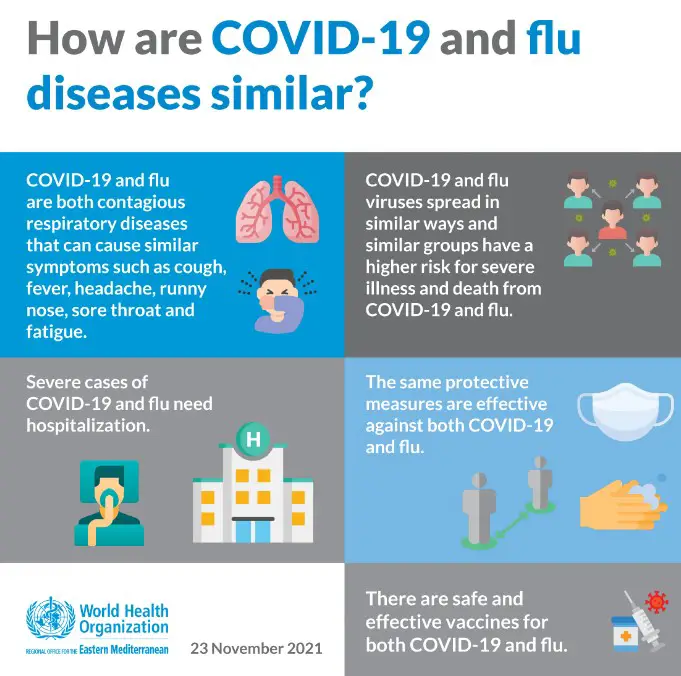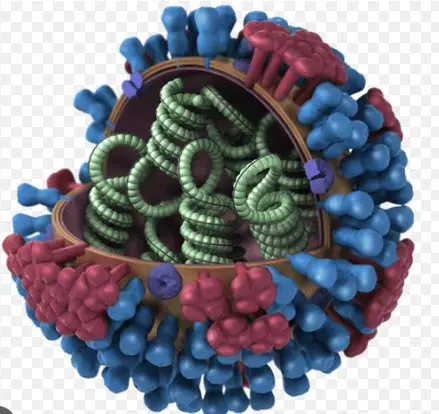Respiratory illnesses significantly impact global health each year, with Coronavirus and Influenza being two of the most prevalent. These viruses, though similar in some of their respiratory symptoms, originate from different viral families and exhibit distinct characteristics and impacts on human health. Recognizing the differences between them is crucial for effective prevention and treatment.
Coronavirus and Influenza differ primarily in their transmission speed and methods, the severity of their symptoms, and the measures necessary for prevention and control. Coronavirus, associated with severe outbreaks like COVID-19, often presents with fever, cough, and breathing difficulties and can rapidly escalate in severity, leading to more significant health complications than Influenza, which typically manifests as a seasonal illness with milder symptoms.
As global travel continues to bind the corners of the world tightly together, understanding these illnesses not only helps in managing personal health but also in responding to public health challenges. The distinctions between these viruses are critical in guiding public health policies, influencing vaccine development, and shaping the responses during pandemic and flu seasons.

What is Coronavirus?
Definition and Brief History
Coronavirus refers to a family of viruses known for containing strains that cause potentially deadly diseases in mammals and birds. In humans, these viruses can lead to respiratory infections ranging from the common cold to more severe diseases such as Middle East Respiratory Syndrome (MERS) and Severe Acute Respiratory Syndrome (SARS). The most recently discovered coronavirus causes coronavirus disease COVID-19, which has led to the global COVID-19 pandemic.
Originally identified in the mid-1960s, coronaviruses are zoonotic, meaning they are transmitted between animals and people. Scientific studies identified that SARS-CoV was transmitted from civet cats to humans in China in 2002 and MERS-CoV from dromedary camels to humans in Saudi Arabia in 2012. The novel coronavirus, SARS-CoV-2, first appeared in Wuhan, China, in late 2019, and has since caused a global pandemic.
Key Characteristics
- Envelope Proteins: Coronaviruses are enveloped viruses with a positive-sense single-stranded RNA genome.
- Spike Proteins: The name “coronavirus” comes from the crown-like spikes on their surface.
- High Mutation Rate: These viruses have a high rate of mutation, which frequently leads to new strains.
What is Influenza?
Definition and Brief History
Influenza, commonly known as the flu, is a highly contagious respiratory illness caused by influenza viruses. It affects the nose, throat, and sometimes the lungs. The flu is seasonal, occurring mainly during the winter months in each hemisphere. Influenza viruses are divided into three types: A, B, and C. Type A and B viruses cause seasonal epidemics, whereas type C causes mild respiratory illnesses and is not a major cause of concern.
The flu has been responsible for numerous pandemics throughout history, with the most notorious being the 1918 Spanish Flu that infected one-third of the world’s population and killed an estimated 50 million people.
Key Characteristics
- Types of Viruses: Three main types of influenza viruses: A, B, and C.
- Highly Contagious: Spread mainly by droplets made when people with the flu cough, sneeze, or talk.
- Seasonal Patterns: Predominantly seen in the winter seasons.
Initial Symptoms
Common Symptoms of Coronavirus
- Fever
- Cough
- Shortness of breath or difficulty breathing
- Fatigue
- Sometimes gastrointestinal symptoms
Common Symptoms of Influenza
- Sudden onset of high fever
- Cough (usually dry)
- Muscle or body aches
- Headaches
- Some people may have vomiting and diarrhea, though this is more common in children than adults
Comparing Initial Presentations
While both illnesses can present with fever and cough, the onset of symptoms in flu is usually sudden, whereas the symptoms of COVID-19 can develop more gradually and can include a significant loss of taste and smell, which is not a feature of the flu.
Transmission Modes
How Coronavirus Spreads
- Person-to-person contact: Mainly through respiratory droplets when an infected person coughs, sneezes, or talks.
- Surface contact: By touching a surface or object that has the virus on it, then touching their own mouth, nose, or possibly their eyes.
How Influenza Spreads
- Droplet transmission: Flu viruses spread mainly by droplets when infected people cough, sneeze or talk.
- Less commonly, by touching surfaces contaminated with the virus.
Differences in Transmission Dynamics
COVID-19 can spread more consistently through the air than influenza and can be spread by asymptomatic individuals, which makes it harder to control. In contrast, flu transmission generally requires some level of symptomatic illness, which allows for more effective isolation of ill persons.
Impact on Health
Short-term Effects of Coronavirus
- Severe respiratory problems
- Acute respiratory distress syndrome (ARDS)
- Potential for rapid deterioration
Short-term Effects of Influenza
- Respiratory symptoms that can lead to severe complications like pneumonia
- Usually resolves on its own without requiring medical attention
Long-term Complications
COVID-19 has been associated with longer-term issues in some patients, including cardiovascular, neurological, and psychological effects, termed “long COVID”. Influenza complications can also include worsening of chronic medical conditions, such as congestive heart failure, asthma, or diabetes.

Risk Groups
High-risk Groups for Coronavirus
The risk of severe illness from COVID-19 increases with age, making older adults at higher risk. People with underlying medical conditions such as heart disease, lung disease, diabetes, obesity, and those whose immune system is compromised due to medical treatment or disease are also at greater risk. Health care workers and those living in long-term care facilities are exposed to higher risks due to their proximity to individuals who may be infected.
High-risk Groups for Influenza
Similar to Coronavirus, the elderly, young children, pregnant women, and individuals with chronic health conditions like asthma, diabetes, or heart disease are particularly vulnerable to Influenza. These groups are more likely to experience severe complications such as pneumonia, bronchitis, sinus infections, and ear infections.
Treatment Approaches
Treatment Options for Coronavirus
Currently, treatment for COVID-19 primarily involves supportive care, which includes symptom management and supportive therapies to support vital organ functions. In severe cases, treatment might involve:
- Oxygen therapy and ventilator support
- Use of medications such as Remdesivir (an antiviral), Dexamethasone (a steroid) to reduce inflammation
- Monoclonal antibodies to help the immune system recognize and respond more effectively to the virus
Treatment Options for Influenza
Treatment for the flu primarily involves antiviral medications that are most effective when taken within the first 48 hours of symptom onset. Common antivirals include:
- Oseltamivir (Tamiflu)
- Zanamivir (Relenza)
- These drugs help reduce the severity and duration of symptoms and are especially crucial for high-risk populations.
Differences in Medical Management
The primary difference in treating these viruses lies in the availability of antiviral medications for Influenza, which can directly target and reduce the duration of flu symptoms, whereas supportive care is more common for managing COVID-19 due to the lack of effective antivirals when the pandemic began.
Prevention Strategies
Preventive Measures for Coronavirus
- Regular and thorough hand washing
- Wearing masks in public settings
- Maintaining social distance to reduce transmission
- Enhanced cleaning and disinfection practices in environments like workplaces and schools
Preventive Measures for Influenza
- Annual flu vaccination, which is the most effective way to prevent flu and its complications
- Good hygiene practices such as covering the mouth and nose when sneezing or coughing
- Avoiding close contact with sick individuals
Vaccination and Its Role
Vaccines play a critical role in controlling both viruses. The flu vaccine is updated annually to match circulating strains and is recommended for almost everyone over the age of six months. COVID-19 vaccines have been developed at an unprecedented pace and have proven effective in reducing the severity of illness, hospitalizations, and deaths caused by the virus.
Testing and Diagnosis
Diagnostic Tests for Coronavirus
- PCR tests: Considered the gold standard for detecting the virus, requiring respiratory samples.
- Antigen tests: Provide faster results and are useful for screening large numbers of people but are less accurate.
- Antibody tests: Used to detect past infections but cannot diagnose current infections.
Diagnostic Tests for Influenza
- Rapid influenza diagnostic tests (RIDTs): Provide results in 15-30 minutes but vary in sensitivity.
- Molecular assays: More accurate and can provide results in approximately 15-60 minutes.
Key Differences in Testing Protocols
While both viruses utilize similar types of tests (PCR, rapid tests), the scale and urgency of testing for COVID-19 have been much greater due to its higher transmission rate and impact on health systems.
Economic and Social Impact
Impact of Coronavirus on Society and Economy
COVID-19 has led to unprecedented disruptions, triggering global economic downturns, overwhelming health systems, and altering daily life with lockdowns and travel restrictions. The long-term economic impacts are profound, affecting employment, education, and international trade.
Impact of Influenza on Society and Economy
While seasonal flu outbreaks are also costly—causing millions of illnesses, hundreds of thousands of hospitalizations, and tens of thousands of deaths annually in the U.S. alone—the economic impact is typically less severe compared to COVID-19 due to shorter durations of illness and more effective vaccination strategies.
Comparative Analysis
The scale of the COVID-19 pandemic has resulted in much larger social and economic disruptions compared to seasonal influenza. The global response has included significant investments in healthcare resources, vaccine development, and public health measures.
Response and Management
Global Response to Coronavirus
The global response to COVID-19 has involved coordinated efforts between countries, including travel bans, lockdowns, emergency funding, and accelerated vaccine development. This response has highlighted the importance of international cooperation in managing health crises.
Global Response to Influenza
The response to seasonal flu is more routine, involving annual vaccine updates and public health campaigns promoting vaccination and hygiene practices.
Lessons Learned and Future Preparedness
Both pandemics have underscored the need for robust health infrastructure, quick scientific response capabilities, and global cooperation. The lessons from managing these diseases are critical for preparing for future health emergencies, emphasizing the need for ongoing investment in health systems, research, and disease surveillance.
Frequently Asked Questions
How do Coronavirus and Influenza spread?
Both viruses are transmitted through respiratory droplets when an infected person coughs, sneezes, or talks. However, Coronavirus can also spread by touching a surface contaminated with the virus, then touching the face, which is less common with Influenza.
What are the common symptoms of Coronavirus and Influenza?
Both viruses cause fever, cough, and body aches, but Coronavirus can also lead to severe respiratory issues, loss of taste or smell, and sometimes gastrointestinal symptoms, which are less common in Influenza cases.
Who is at higher risk from Coronavirus and Influenza?
Older adults, those with underlying health conditions, and immunocompromised individuals face higher risks from both viruses. However, Coronavirus has shown a higher rate of severe complications and fatalities, especially in these high-risk groups.
Are there effective treatments for both viruses?
Influenza can be treated with antiviral drugs that are most effective when administered early. Treatment options for Coronavirus include supportive care to relieve symptoms, with severe cases needing hospitalization and sometimes respiratory support.
How can we prevent the spread of these viruses?
Preventative measures include frequent hand washing, wearing masks, and avoiding close contact with sick individuals. Vaccination is a crucial preventative measure for both viruses, though the specific vaccines differ.
Conclusion
The need to distinguish between Coronavirus and Influenza is more than academic; it’s a vital component of global health literacy. Awareness and understanding of the differences between these two viruses enable individuals and healthcare systems to prepare more effectively, ensuring timely and appropriate responses that can save lives.
In the end, both personal and collective health measures are essential in managing the spread of these illnesses. By staying informed about symptoms, transmission, and prevention, communities can better navigate the challenges posed by these impactful viruses, ultimately leading to better health outcomes and resilience against future outbreaks.

